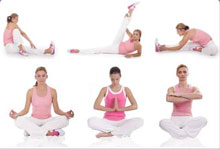Breathing Exercises in Office
There are a lot of different breathing exercises that you can practice, especially when you are in a stressful situation at work.
We often do not stop to think about what’s happening to our body when we are stressed.
In fact, stress actually affects a lot of physiological functions in the body – especially breathing and respiration. However, the stress of the moment keeps us so preoccupied that we hardly ever think about our body and the damage being inflicted on it. Thankfully there are some simple breathing exercises that can be performed when you are stressed. These deep breathing exercises can help you calm your body and reduce the negative effects of stress on your organs.
Breathing Exercises in Office
The office is where you spend most of your time throughout the day. It is also most likely to be the place where you experience the most stress. So naturally, you should consider practicing some deep breathing exercises in office every time you feel stressed or uncomfortable. Here are some simple breathing techniques for stress in the workplace:
- Relax in your chair or in the break room and take in a deep breath. Feel your abdomen inflate and deflate with each breath and concentrate only on your breathing rhythm. Inhale deeply from your nose and release slowly through your pursed lips.
- Of all the breathing exercises to relax, the best one is to take in a deep breath and count to yourself while doing it. Then exhale and count again. Repeat this several times till you are breathing in a rhythm and your mind is no longer concentrating on the stressful situation.
- Sink into your office chair and take in a deep breath. As you exhale slowly, allow your body to go limp in your chair. If your body feels heavy, you are doing it right. Keep repeating this till you feel relaxed and comfortable.
In addition to these simple breathing exercises, you can also practice yoga and pranayama breathing exercises, which help you become healthier and more relaxed.
These exercises also help you cleanse your body and infuse it with energy, which goes a long way to help deal with anxiety. Learning some meditation breathing techniques as these can be really beneficial and can be practiced anywhere at any time. In dealing with anxiety, when you are practicing office meditation, you may need to get access to a peaceful corner. You may choose to take a small break and walk yourself to the terrace or a nearby park. Some of these breathing exercises for anxiety may take time and you may have to utilize your lunch break for them.
Benefits of Breathing Exercises
Our bodies are equipped with a simple relaxation response. Every time you perform any kind of relaxation technique or deep breathing exercise, the body triggers the relaxation response. However, this response needs to be induced to reduce anxiety. It also helps reduce and prevent cumulative stress. Once you are relaxed, you will experience improved concentration and increased levels of energy. Studies have shown that relaxed bodies also tend to harbor greater self-esteem and self-confidence.
Deep breathing benefits the body and mind in a lot of ways. Relaxation exercises are an extremely powerful tool for managing and fighting stress. In fact, stress has been linked to some of the major causes of death, including suicide, depression, cancer and heart disease. In the workplace, health benefits of breathing exercises can be really seen. Stress causes increasing absenteeism and loss in productivity. In fact, studies have shown that the American industry loses more than $300 billion every year due to stress. Deep breathing exercises, when performed regularly can drastically lower stress levels and improve overall productivity.
 Find Pose
Find Pose

